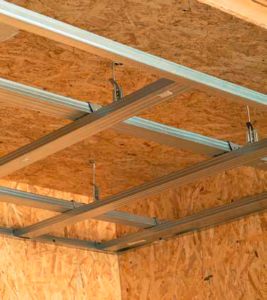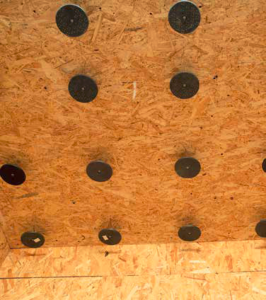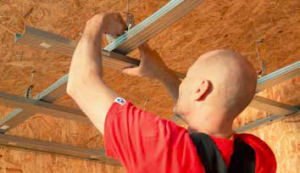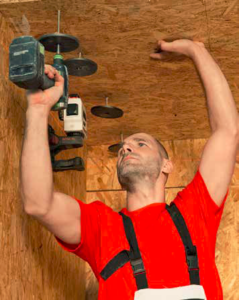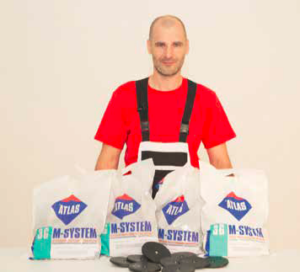- Products
- Systems
- Tools & Services
News
Fixing plasterboards upon a ceiling – comparison of two systems
Nowadays, one may choose between two existing solutions for fixing plasterboards upon a ceiling. The first one involves a construction made of metal profiles installed in a transverse arrangement. The second technology uses self-aligning connectors introduced by ATLAS M-System. We are going to compare these two systems.
t is up to the contractor whether he wants to earn X € / ₤ in e.g. 4 days using frame installation or the same amount of money in twice shorter time using M-System. Having in mind the current situation on market in which the contractors have the work scheduled for a couple of months ahead each saved day is very precious.
|
System components |
|
|
Metal frame |
M-System |
|
Multicomponent system |
All components in a single packaging |
|
Frame system in a transverse arrangement is composed of many elements which are to be matched so that the load-bearing construction for boards is formed. The system comprises the following elements: |
ATLAS M-System combines all necessary components in a single, convenient packaging. One packaging is enough to cover 4 m2 of construction for boards. The packaging includes: |
|
– perimeter profile UD30 |
– mounting discs |
|
– main profile CD60 |
– threaded rods L100, L150, L200, L250 |
|
– adjustable hangers |
– plastic expansion sleeves to be inserted in the substrate |
|
– transverse braces |
– steel screws for fixing the plasterboards |
|
– rawlplugs |
|
|
– 3.5 mm steel screws |
|
|
– screws for boards fixing |
|
|
– extensions for profiles |
|
|
– acoustic tape |
|
|
Spacing to the substrate |
|
|
Minimum room height reduction is 14 cm |
The smallest loss of space (0.6 cm) |
|
A traditional construction allows for minimum spacing of 14 cm between the ceiling and plasterboards. It results from the transverse arrangement of the profiles and the need for using hangers. It is rather a lot and may be of immense importance in case of renovating rooms with small ceiling height. |
M-system connector can be easily adjusted, thus it is possible to achieve a minimum spacing of 0.6 cm between the ceiling and plasterboard (it is slightly more than the thickness of the mounting disc). This gives vast opportunities at areas where the smallest possible loss of space is the priority due to room purpose or investor’s need. M-System connectors can also be extended up to max. 55 cm. In order to achieve this, one must apply the extension element made of M6 threaded rod to connector with metric thread. |
|
System installation |
|
|
Requires professional knowledge |
Easy technology |
|
Fix UD30 profiles to the walls. They form the perimeter profiles which determine the level of future ceiling. UD profiles should be also taped with an acoustic tape to minimize potential vibrations. The next step is to attach rotating hangers to the ceiling using rawlplugs and to fix the first layer of CD 60 profiles to them after they are cut to given length with scissors for metal sheet. Then, using transverse connectors one needs to mount the second layer of profiles, sliding them simultaneously in the perimeter profiles. In order to fit within the allowable deviations, one must carefully measure the profiles arrangement. It is essential so that the profiles are not rigidly installed, but there is a possibility for small displacement (neither can they be fixed together). The entire structure (load-bearing and main profiles as well as the transverse connectors) must be screwed with 3.5 mm long screws. To sum up, the installation of frame requires connecting many elements one to another. It is very labor-intensive work. One needs to do all the measurements and match the profiles. Moreover, the holes must be drilled (for hangers and perimeter profiles) and elements must be screwed one to another. There is a large risk of installation errors. Such installed lining is connected to the wall with the perimeter profile. It is possible that the internal tension appears in the structure. This can easily lead to plasterboard cracking. |
Ultimately, the same construction solution involving plasterboards can be achieved in a much simpler way using ATLAS technology. One firstly needs to plan the joints between the boards and the arrangement of holes. Then the connectors must be screwed up to the level indicated by the laser line. In ATLAS M-System the entire construction has no direct connection to the wall and behaves like a floating structure. |
|
Scratches and cracking |
|
|
High risk |
Low risk |
|
There may be several main causes for cracks and scratches on the ceiling in case of frame system, for example: – Installation errors – they result from the fact that frame system is composed of many connectors and profiles. If they are screwed improperly the internal tension may occur. |
Installation errors and construction failures mentioned on the left side of the table are much rarer when one uses M-System. It is due to the fact that: – Installation is much easier and simpler, – The whole M-System structure can move (there is a possibility of displacement) and works like a floating structure; connectors are not connected to each other; – All system components are included in one packaging; they were carefully examined by ITB (Polish Institute for Building Technology). ITB certificate guarantees that every element in the system was tested, e.g. in view of shearing, bending, pulling out and tensile test. The results confirmed that ATLAS M-System is a safe and secure solution for the contractors and investors. All the elements are compatible, thus it is impossible to mismatch the individual elements, – Manufacturer’s warranty covers the entire |
|
Costs |
|
|
Long working time |
Time saving method |
|
Installation of the given ceiling area, e.g. 100 m2 takes 4 days
Fixed labour cost – X € / ₤ |
Installation of the same given ceiling area, e.g. 100 m2 takes 50% time less: 2 days instead of 4
Fixed labour cost – X € / ₤ |
|
Conclusion: The overall materials cost is similar in both systems. It is up to the contractor whether he wants to earn X € / ₤ in e.g. 4 days using frame installation or the same amount of money in twice shorter time using M-System. Having in mind the current situation on market in which the contractors have the work scheduled for a couple of months ahead each saved day is very precious. |
|
Resume
ATLAS M-System is superior to the traditional frame system:
- lower risk of cracking
- the ceiling made of plasterboards is installed two times faster in comparison to traditional technology
- the construction is much easier to install
- it is possible to make a minimum spacing between the original and installed ceiling – there is very little loss of room space
Original text: Mariusz Jurkiewicz, ATLAS Group
English text: Piotr Marciniak, ATLAS Group
